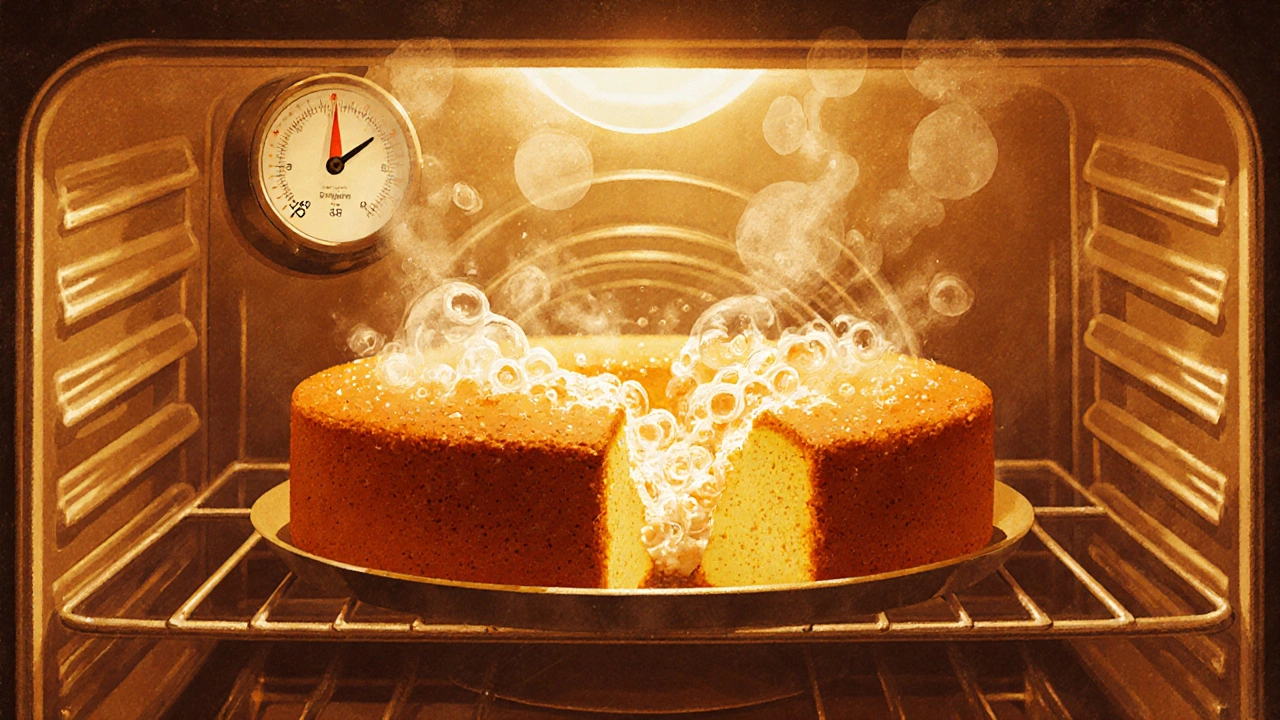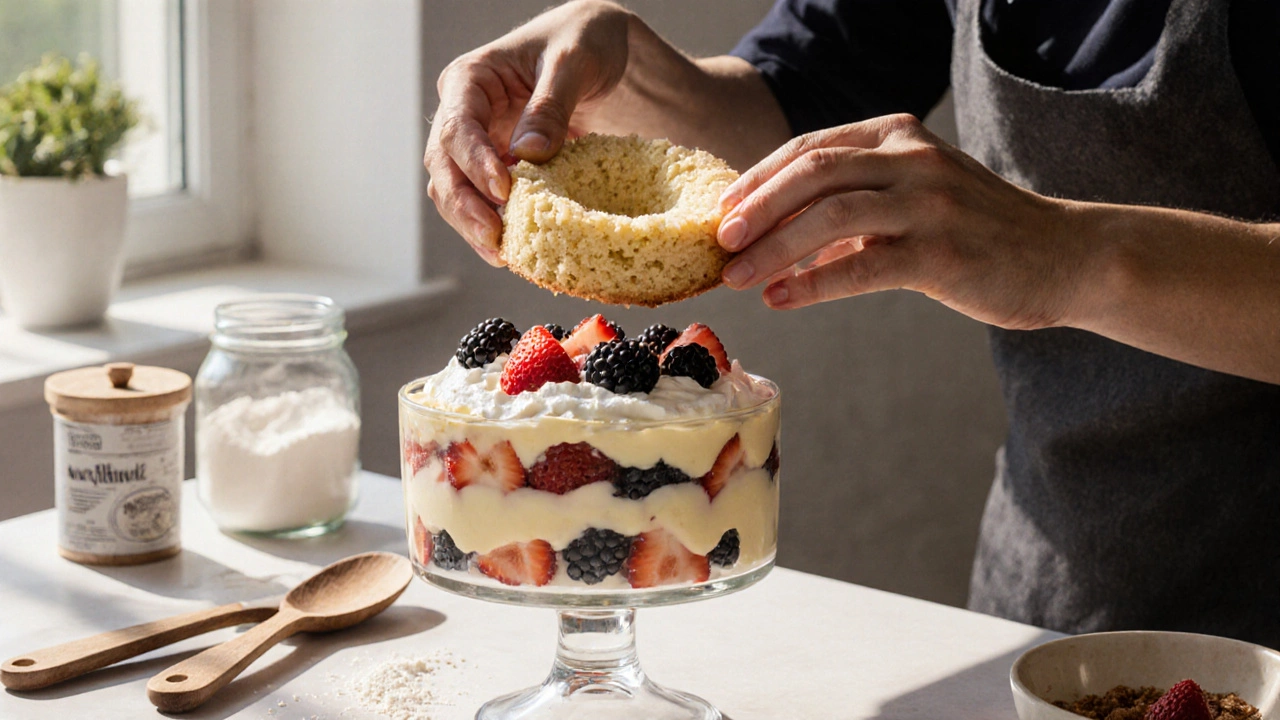Nothing kills a baking win faster than a beautiful cake that sinks in the middle. You take it out of the oven, proud of your smooth batter and even browning-only to find a deep crater where the center should be. It’s not just ugly. It’s frustrating. And yes, it happens to even experienced bakers. But sinking cake isn’t magic or bad luck. It’s usually one or two simple mistakes, and once you know what to look for, you can fix it for good.
What Exactly Is a Sinking Cake?
A sinking cake is when the center of the cake collapses after baking, creating a dip, dent, or even a tunnel. It doesn’t always sink all the way to the bottom-sometimes it’s just a slight dip, but it’s enough to ruin the look and texture. This isn’t the same as a cake that’s underbaked. A sinking cake often looks fully cooked on the outside, maybe even a little browned, but the inside structure didn’t hold. The crumb might be dense, gummy, or uneven around the sunken area.Why Does Cake Sink in the Middle?
There are five main reasons cakes sink. Most bakers blame the oven, but it’s rarely the culprit. Here’s what actually causes it:- Too much leavening agent-Baking powder or baking soda is meant to help the cake rise. But if you use too much, the cake puffs up too fast, then the structure can’t support itself. The center collapses as it cools. A common mistake? Using a heaped teaspoon instead of a level one. One extra 1/4 teaspoon can be enough to ruin a 9-inch cake.
- Underbaking-If the cake’s center isn’t set when you take it out, gravity wins. The structure hasn’t formed yet. Even if the top looks done, the middle might still be wet. The cake rises during baking, then falls as it cools because it never fully set.
- Opening the oven door too early-Every time you open the oven in the first 20-25 minutes, you drop the temperature by 25-50°F. That sudden cold shock can cause the cake’s air bubbles to collapse before the structure solidifies. Don’t peek until at least three-quarters of the baking time has passed.
- Too much liquid or fat-Recipes that call for extra yogurt, sour cream, or oil can throw off the balance. Cakes need a precise ratio of dry to wet ingredients. Too much moisture means the structure can’t hold up. The cake rises, but the center stays soft and sinks.
- Old or expired leaveners-This one’s sneaky. If your baking powder is older than 6 months, it might not activate properly. You think it’s working because the cake rises a little, but the lift is weak and uneven. The cake might puff up, then fall slowly as the gas escapes without support.

How to Tell If Your Cake Is Underbaked or Just Sunk
It’s easy to confuse a sunken cake with an underbaked one. Here’s how to tell the difference:- Underbaked cake: The center feels soft or jiggly when you gently shake the pan. A toothpick comes out with wet batter. The cake smells raw. It may sink, but it also feels doughy.
- Sunken cake: The center is firm to the touch. A toothpick comes out clean. The cake smells fully baked. But the middle dips down, sometimes with a slight crust around the edges. The crumb is dry or dense around the sunken area.
If your cake is underbaked, just put it back in the oven for 5-10 more minutes. If it’s sunk but fully baked? That’s a structural failure. You need to fix your technique, not your bake time.
How to Prevent Your Cake From Sinking
Fixing a sinking cake starts before you even turn on the oven. Here’s what to do every time:- Measure your leavening agents accurately. Use measuring spoons, not kitchen knives or eyeballing. Level off baking powder and baking soda with the back of a knife. Don’t pack it down.
- Check your baking powder’s freshness. Drop a teaspoon into a cup of hot water. If it fizzes hard and fast, it’s good. If it barely bubbles, toss it. Replace it every 6 months.
- Don’t open the oven door until the cake has baked for at least 75% of the time. For a 35-minute cake, wait until 25 minutes have passed. Use the oven light and window instead.
- Use the right pan size. If you use a 9-inch pan instead of an 8-inch, the batter spreads thinner. It bakes faster on the edges but the center stays undercooked. Stick to the recipe’s pan size.
- Let ingredients come to room temperature. Cold butter or eggs don’t mix evenly. That leads to uneven air pockets. Take them out 1-2 hours before baking.
- Don’t overmix the batter. Mix just until the flour disappears. Overmixing develops gluten, which makes the cake tough and dense. It can’t rise properly, so it sinks.

What to Do If Your Cake Already Sank
You baked it. It sank. Now what?You don’t have to throw it away. Here are three ways to save it:
- Turn it into cake pops. Crumble the cake, mix it with frosting, roll into balls, dip in chocolate. No one will know the center sank.
- Fill the dip with frosting or fruit. Pipe whipped cream, jam, or ganache into the sunken center. It looks intentional-like a filled cake.
- Use it as a trifle layer. Layer the cake with custard, berries, and whipped cream in a glass bowl. The sink becomes part of the texture.
Don’t feel bad. Even professional bakers have sinking cakes. The difference? They know why it happened-and how to stop it next time.
Quick Fix Checklist for Sinking Cake
Keep this list taped to your fridge or saved on your phone:
- ✅ Measured leavening agents with spoons (not scooped)
- ✅ Baking powder is less than 6 months old
- ✅ Oven door stayed shut until 75% of bake time
- ✅ Used the exact pan size in the recipe
- ✅ Ingredients at room temperature
- ✅ Batter mixed just until combined
- ✅ Toothpick test clean in the center before removing from oven
If you check all these, your cakes will rise evenly-and stay that way.